Uncategorized
Crypto Daybook Americas: The 2 Factors That Suggest a Quarter-End BTC Price Rally

By Omkar Godbole (All times ET unless indicated otherwise)
The crypto market has steadied over the past two days, with bitcoin briefly topping the 200-day simply moving average at $84,000 early today. Wednesday’s softer-than-expected U.S. CPI release aided the sentiment by validating traders’ pricing of four interest-rate cuts by the Federal Reserve this year.
The past 24 hours’ recovery was led by the memecoin sector, followed by tokens of layer-1 and layer-2 blockchains as well as AI tokens, according to data source Velo.
Still, issues such as President Trump’s tariffs, U.S. recession concerns and the bond-market volatility that recently rocked risk assets, including BTC, remain to cast doubt on the sustainability of the market recovery. That said, at least two factors suggest otherwise.
The first is the quarter-end rebalancing. The Nasdaq and S&P 500 are down 6% and 4.8%, respectively, this quarter, while the 10-year Treasury note is up 5%. That means funds mandated to maintain a specific asset allocation mix are now overweight bonds and will probably rebalance by buying equities and selling bonds as the quarter end nears.
Those actions will push bond yields and stock prices higher and could bode well for bitcoin and the broader crypto market, given the strong correlation between BTC and the technology stocks.
The other factor is the yen, which has come under pressure since CoinDesk noted the potential for renewed crypto market stability on the back of overstretched bullish positioning in the Japanese currency. The yen, seen as a haven investment, may remain under pressure as the potential quarter-end rebalancing lifts U.S. bond yields. In other words, risk-off stemming from the JPY strength and the resulting unwinding of the yen carry trades may be over for now.
Positive net global liquidity could also grease risk-taking.
«Net global liquidity, largely due to China and the U.S., is increasing,» Two Prime, an SEC-registered investment adviser, said in a Telegram chat. «This may counteract some of the effects of the yen trade’s unwind. In addition, as the U.S. gets its own rates and inflation under better control, which has already started to incrementally trend down over the past few months, it will reduce pressure on other central bank bonds and slow rate growth on yen borrow.»
Still, traders need to be vigilant for volatility, as Deribit’s BTC-listed options market tracked by Amberdata shows significant negative dealer gamma between $81,000 and $87,000. Dealers are likely to trade in the direction of the market to maintain their overall exposure neutral, adding to price swings.
The U.S. is set to publish the February producer price index (PPI) report and the weekly jobless claims later today. A hotter-than-expected PPI, representing pipeline inflation, may inject downside volatility into risk assets. Stay alert!
What to Watch
Crypto:
March 15: Athene Network (ATH) mainnet launch.
March 15: Reploy will close its V1 RAI staking program to new users as it transitions to a fully automated revenue-sharing protocol.
March 17: CME Group launches solana (SOL) futures.
March 18: Zano (ZANO) hard fork network upgrade which activates “ETH Signature support for off-chain signing and asset operations.”
March 20: Pascal hard fork network upgrade goes live on the BNB Smart Chain (BSC) mainnet.
Macro
March 13, 8:30 a.m.: The U.S. Bureau of Labor Statistics (BLS) releases February producer price inflation data.
Core PPI MoM Est. 0.3% vs. Prev. 0.3%
Core PPI YoY Est. 3.6% vs. Prev. 3.6%
PPI MoM Est. 0.3% vs. Prev. 0.4%
PPI YoY Est. 3.3% vs. Prev. 3.5%
March 14, 8:00 a.m.: The Brazilian Institute of Geography and Statistics (IBGE) releases January producer price inflation data.
PPI MoM Prev. 1.48%
PPI YoY Prev. 9.42%
March 16, 10:00 p.m.: The National Bureau of Statistics of China releases February employment data.
Unemployment Rate Prev. 5.1%
Earnings (Estimates based on FactSet data)
March 14: Bit Digital (BTBT), pre-market, $-0.05
March 24 (TBC): Galaxy Digital Holdings (TSE: GLXY), C$0.38
Token Events
Governance votes & calls
Uniswap DAO is discussing continuing treasury delegation to maintain governance stability and retain active delegates, including a renewed framework and structure expiration and allocation mechanisms.
ApeCoin DAO is discussing the establishment of an APE base in Lhasa, Tibet Autonomous Region, China. It’s also discussing the creation of ApeSites, which aims to provide the BAYC community with an “easy-to-use tool to create personalized websites.”
Aave DAO is discussing the formalization of a six-month agreement with Chainlink on the potential integration of the Chainlink Smart Value Recapture (SVR) system.
March 13, 10 a.m.: Mantra to host a Community Connect call with its CEO and co-founder to discuss various major updates.
March 13, 10 a.m.: Mantle Network to hold a Surge Ask Me Anything (AMA) session.
March 13, 11:30 a.m.: Jupiter to hold a Planetary Call.
March 13, 2 p.m.: THORChain to hold an X Spaces session on TCY / THORFi recovery.
Unlocks
March 14: Starknet (STRK) to unlock 2.33% of its circulating supply worth $11.16 million.
March 15: Sei (SEI) to unlock 1.19% of its circulating supply worth $10.65 million.
March 16: Arbitrum (ARB) to unlock 2.1% of its circulating supply worth $32.33 million.
March 18: Fasttoken (FTN) to unlock 4.66% of its circulating supply worth $79.80 million.
March 21: Immutable (IMX) to unlock 1.39% of circulating supply worth $13.19 million.
March 23: Metars Genesis (MRS) to unlock 11.87% of its circulating supply worth $97.6 million.
March 23: Mantra (OM) to unlock 0.51% of its circulating supply worth $32.4 million.
Token Listings
March 13: Nano (XNO) to be listed on OKX.
March 18: Paws (PAWS) to be listed on Bybit.
March 31: Binance to delist USDT, FDUSD, TUSD, USDP, DAI, AEUR, UST, USTC, and PAXG.
Conferences
CoinDesk’s Consensus is taking place in Toronto on May 14-16. Use code DAYBOOK and save 15% on passes.
Day 1 of 2: Web3 Amsterdam ‘25
March 16, 6:00 p.m.: Solana AI Summit (San Jose, Calif.)
March 18-20: Digital Asset Summit 2025 (New York)
March 18-20: Fintech Americas Miami 2025
March 19-20: Next Block Expo (Warsaw)
March 24-26: Merge Buenos Aires
March 25-26: PAY360 2025 (London)
March 25-27: Mining Disrupt (Fort Lauderdale, Fla.)
March 26: Crypto Assets Conference (Frankfurt)
March 26: DC Blockchain Summit 2025 (Washington)
March 26-28: Real World Crypto Symposium 2025 (Sofia, Bulgaria)
March 27: Building Blocks (Tel Aviv)
March 27: Digital Euro Conference 2025 (Frankfurt)
March 27: WIKI Finance EXPO Hong Kong 2025
March 27-28: Money Motion 2025 (Zagreb, Croatia)
March 28: Solana APEX (Cape Town)
Token Talk
By Shaurya Malwa
The cost of missing out on potential airdrops has been massive for potential recipients in the U.S., according to a Thursday report by Dragonfly Capital.
Up to 5.2 million American crypto users have been excluded from airdrops, missing out on an estimated $3.49 billion to $5.02 billion in token value, based on broader data.
That’s just the tip of the iceberg: 22%–24% of active crypto wallets are American, but they’ve been systematically cut off. The U.S. government lost out too, with $418 million to $1.1 billion in federal tax revenue gone, plus $107 million to $284 million in state taxes.
Regulatory confusion in the U.S. forced crypto projects to play it safe. Many blocked U.S. participants outright, moved their operations to other countries, or tweaked their airdrop designs to dodge potential lawsuits or penalties.
This created a big divide: While crypto adoption exploded worldwide, the U.S. lagged behind. Projects didn’t want to risk breaking unclear rules, so they geofenced Americans out — meaning U.S. users couldn’t claim tokens.
Things might be starting to shift, though. The policy environment in the U.S. is changing, with signs that regulators and lawmakers could ease up on crypto restrictions, Dragonfly concluded.
Derivatives Positioning
BNB, ETH, XLM, DOT and OM are the only top-25 coins by market value boasting positive perpetual futures cumulative volume deltas for the past 24 hours, according to data sourve Velo. It’s a sign of net buying pressure.
Positioning in CME’s bitcoin futures remains light, with open interest at 146K BTC, barely higher than the recent multimonth low of 140.84 BTC. The same can be said about CME’s ETH futures.
BTC’s CME basis remains stuck between annualized 5% and 10%, while ETH’s has bounced to nearly 7% from the recent low of 4%.
BTC and ETH puts are trading pricier than calls out to the May-end expiry on Deribit, reflecting persistent downside fears.
Block flows featured a long BTC straddle, a bullish vol play and outright buys in OTM puts.
Market Movements:
BTC is unchanged from 4 p.m. ET Wednesday at $83,335.37 (24hrs: +0.98%)
ETH is down 0.29% at $1,896.33 (24hrs: -0.4%)
CoinDesk 20 is up 0.55% at 2,596.89 (24hrs: +1.65%)
Ether CESR Composite Staking Rate is down 27 bps at 3.16%
BTC funding rate is at 0.0038% (4.18% annualized) on Binance
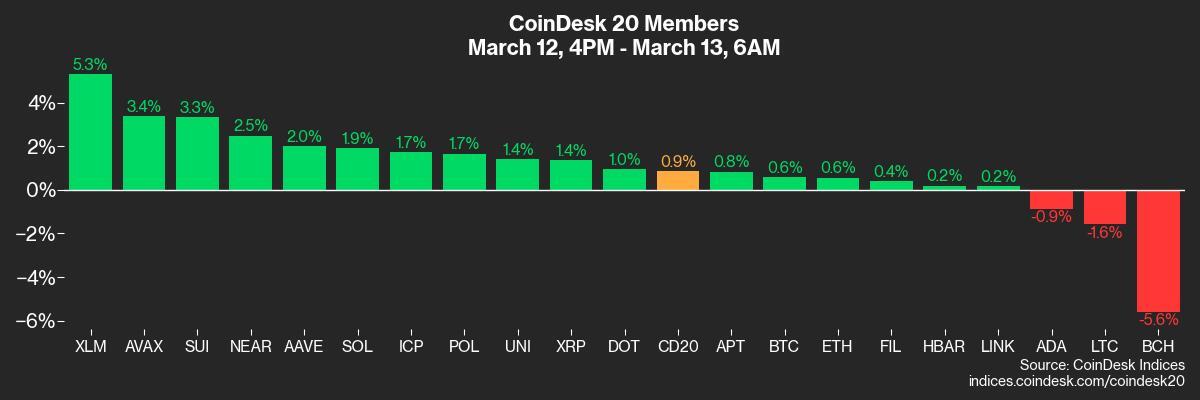
DXY is unchanged at 103.66
Gold is up 0.15% at $2,943.76/oz
Silver is down 0.48% at $33.11/oz
Nikkei 225 closed unchanged at 36,790.03
Hang Seng closed -0.58% at 23,462.65
FTSE is up 0.38% at 8,573.66
Euro Stoxx 50 is up 0.25% at 5,372.83
DJIA closed on Wednesday -0.2% at 41,350.93
S&P 500 closed +0.49% at 5,599.30
Nasdaq closed +1.22% at 17,648.45
S&P/TSX Composite Index closed +0.72% at 24,423.34
S&P 40 Latin America closed +0.81% at 2,326.29
U.S. 10-year Treasury rate is up 1 bp at 4.33%
E-mini S&P 500 futures are up unchanged at 5,604.25
E-mini Nasdaq-100 futures are unchanged at 19,602.00
E-mini Dow Jones Industrial Average Index futures are unchanged at 41,411.00
Bitcoin Stats:
BTC Dominance: 61.97 (-0.21%)
Ethereum to bitcoin ratio: 0.02272 (-0.39%)
Hashrate (seven-day moving average): 832 EH/s
Hashprice (spot): $46.1
Total Fees: 5.19 BTC / $428.778
CME Futures Open Interest: 143,790 BTC
BTC priced in gold: 28.3 oz
BTC vs gold market cap: 8.04%
Technical Analysis
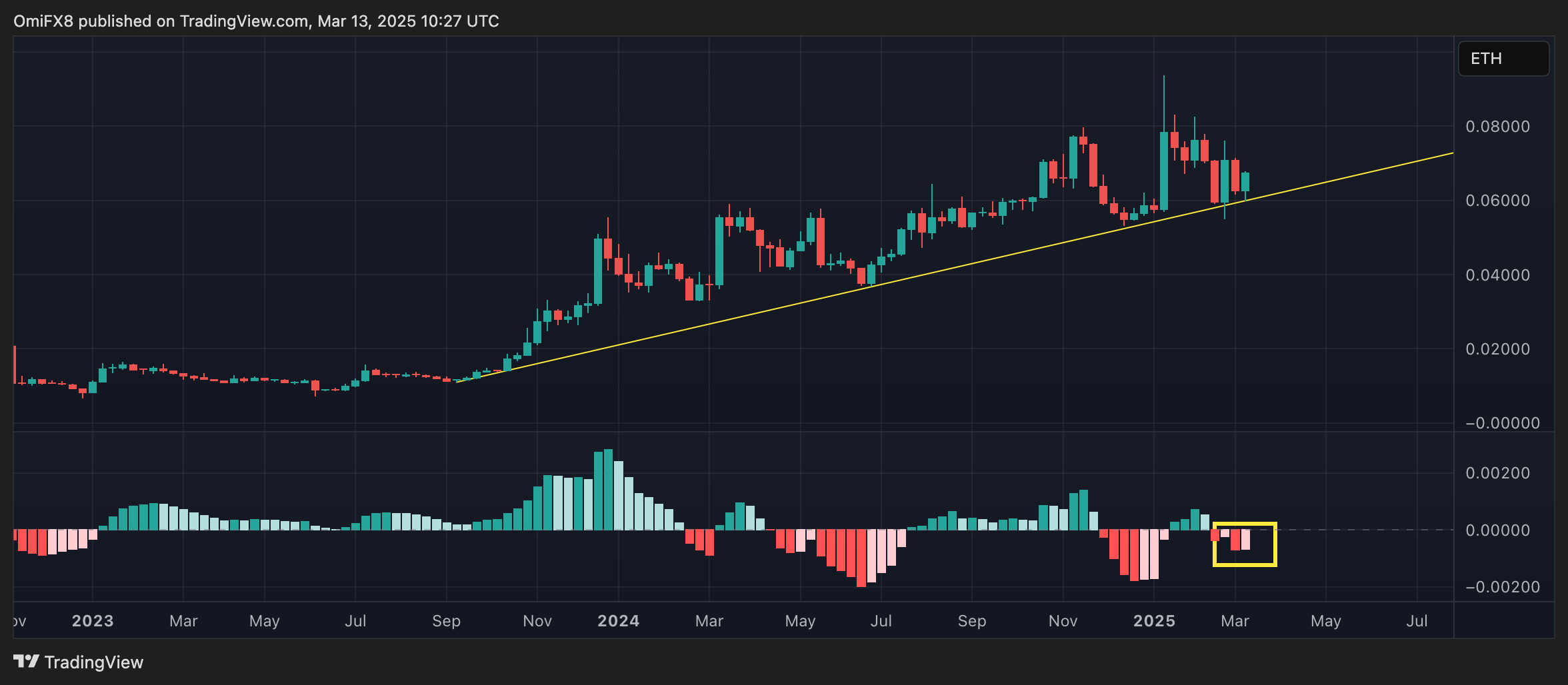
The SOL/ETH ratio continues to hold the bull market trendline despite the MACD, a momentum indicator, flashing negative readings for the fourth straight week.
That’s a sign of underlying strength in the market and potential for a continued SOL outperformance relative to ether.
Crypto Equities
Strategy (MSTR): closed on Wednesday at $262.55 (+0.75%), down 0.63% at $260.89 in pre-market
Coinbase Global (COIN): closed at $191.73 (+0.02%), down 0.18% at $191.39
Galaxy Digital Holdings (GLXY): closed at C$17.50 (+1.33%)
MARA Holdings (MARA): closed at $13.11 (-1.58%), up 1.07% at $13.25
Riot Platforms (RIOT): closed at $7.85 (+1.68%), down 0.25% at $7.83
Core Scientific (CORZ): closed at $8.95 (+3.71%), down 1.12% at $8.85
CleanSpark (CLSK): closed at $8.10 (-1.94%), down 0.62% at $8.05
CoinShares Valkyrie Bitcoin Miners ETF (WGMI): closed at $15.29 (+1.39%)
Semler Scientific (SMLR): closed at $33.60 (+2.44%)
Exodus Movement (EXOD): closed at $27.43 (+11.96%), down 5.18% at $26.01
ETF Flows
Spot BTC ETFs:
Daily net flow: $13.3 million
Cumulative net flows: $35.49 billion
Total BTC holdings ~ 1,117 million.
Spot ETH ETFs
Daily net flow: -$10.3 million
Cumulative net flows: $2.70 billion
Total ETH holdings ~ 3.555 million.
Source: Farside Investors
Overnight Flows
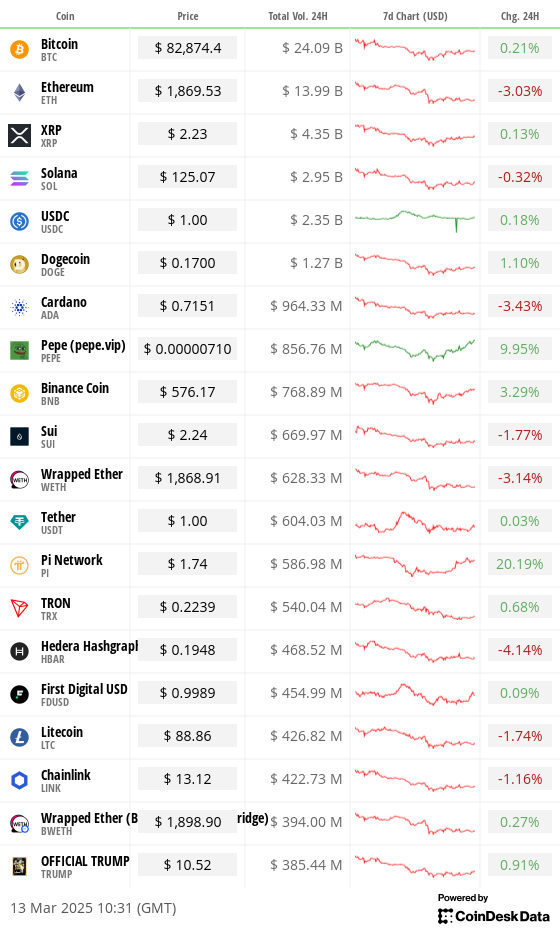
Chart of the Day
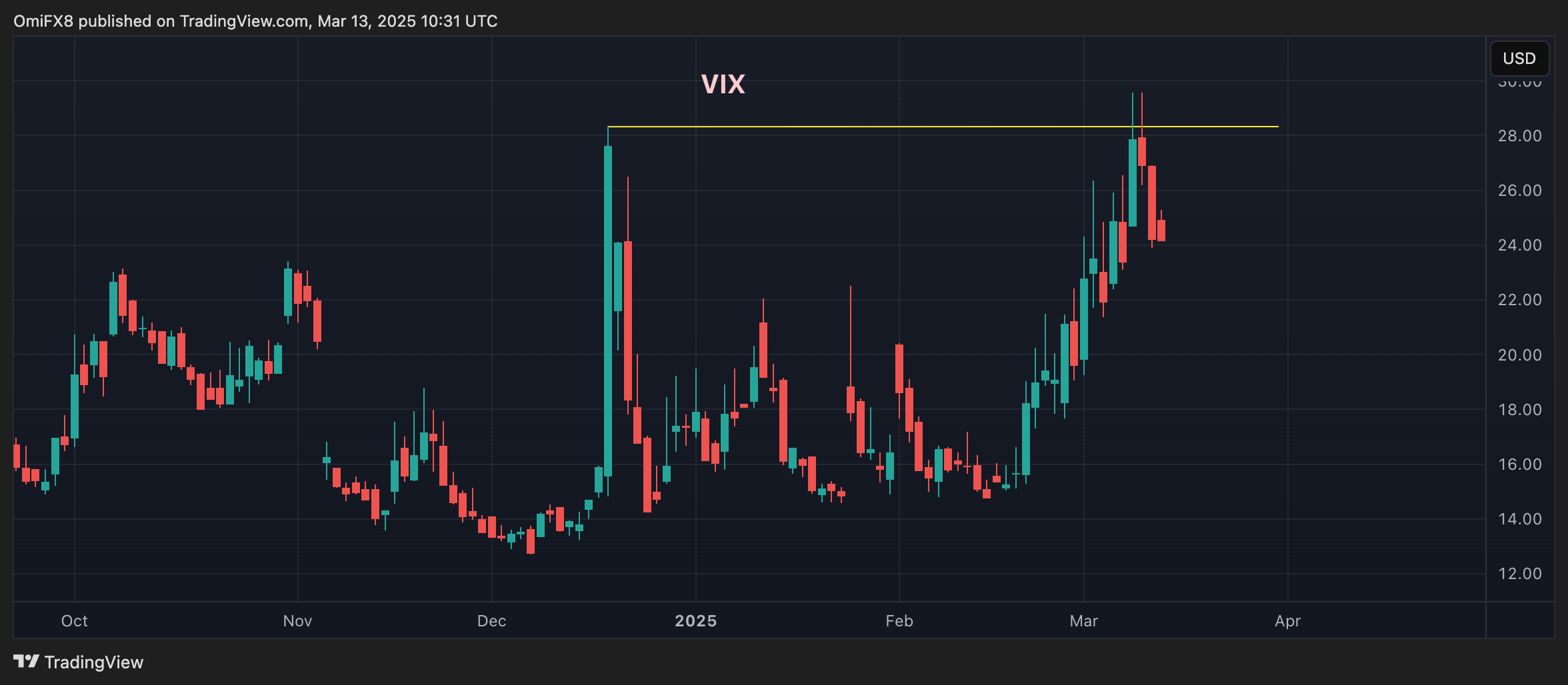
The VIX index, Wallstreet’s so-called fear gauge, has turned lower from the December high, hinting at a renewed risk-on upswing in stocks.
That could bode well for cryptocurrencies.
While You Were Sleeping
Poland’s President Urges U.S. to Move Nuclear Warheads to Polish Territory (Financial Times): Andrzej Duda said NATO’s nuclear deterrent should move eastward, citing the alliance’s expansion and Russia’s deployment of nuclear weapons in Belarus.
Worst of U.S. Equity Correction Is Likely Over, JPMorgan Say (Bloomberg): JPMorgan strategists said U.S. credit markets suggest a lower recession risk than equities, indicating recent stock declines may stem from hedge funds unwinding positions rather than economic fundamentals.
Consumer Angst Is Striking All Income Levels (The Wall Street Journal): U.S. consumers are spending less as shrinking savings and weaker wage growth limit their budgets, while tariff concerns stoke expectations of higher inflation and recession.
BOJ Set to Hold Rates This Month, Hike to 0.75% in Q3, Most Likely July: Reuters Poll (Reuters): A Reuters survey found 90% of economists see Trump’s tariffs hurting Japan’s economy, while 70% anticipate the Bank of Japan will raise rates in the third quarter.
Crypto Scam: Request Made for International Arrest of Hayden Davis (Página/12): An Argentine lawyer asked a federal prosecutor seek an international arrest warrant and Interpol Red Notice for Hayden Davis, aiming for his extradition over alleged involvement in the LIBRA memecoin scandal.
XRP Short Bias Lingers Amid Ripple Legal Hopes, DOGE Nears Death Cross as BTC Dominance Hits 4-Year High (CoinDesk): XRP’s price has rebounded, but traders are still betting against it in futures markets, signaling skepticism about its rally. Several other altcoins display similar bearish positioning.
In the Ether
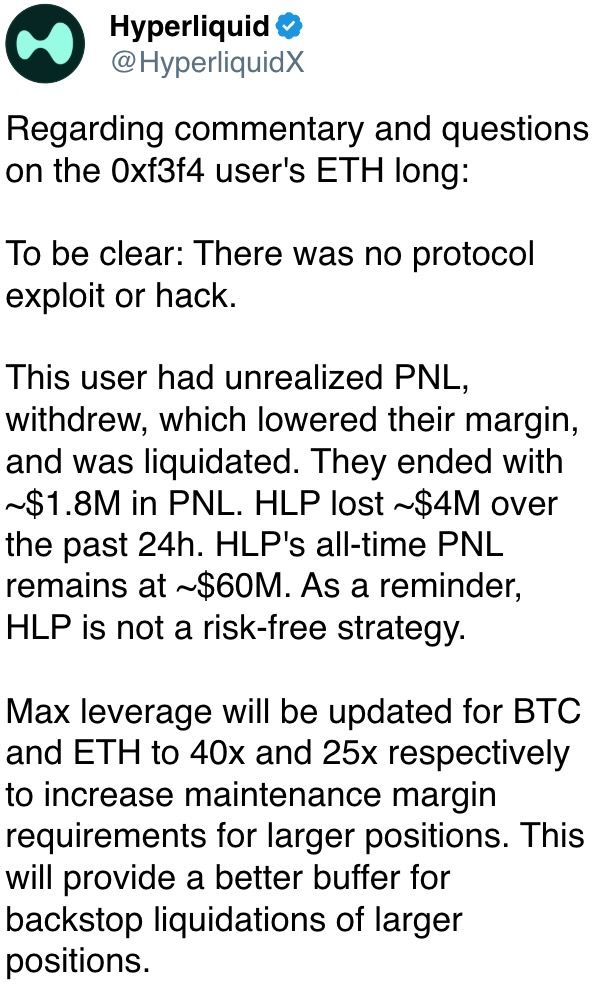
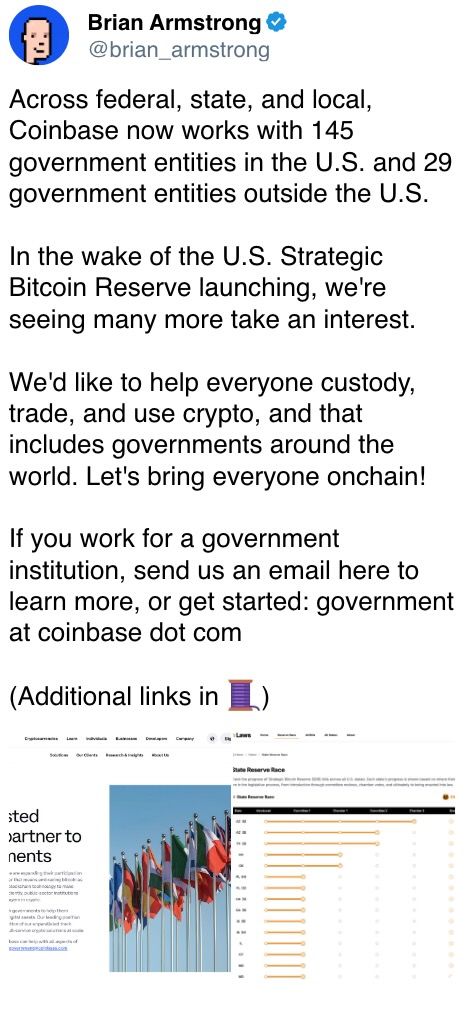
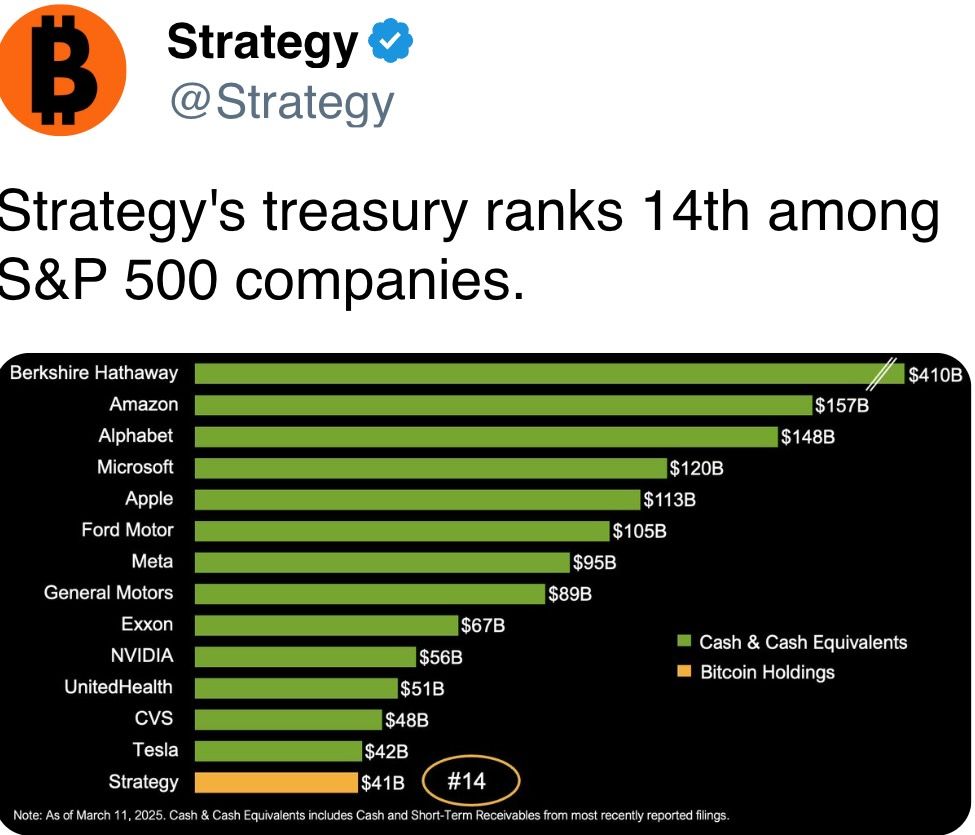
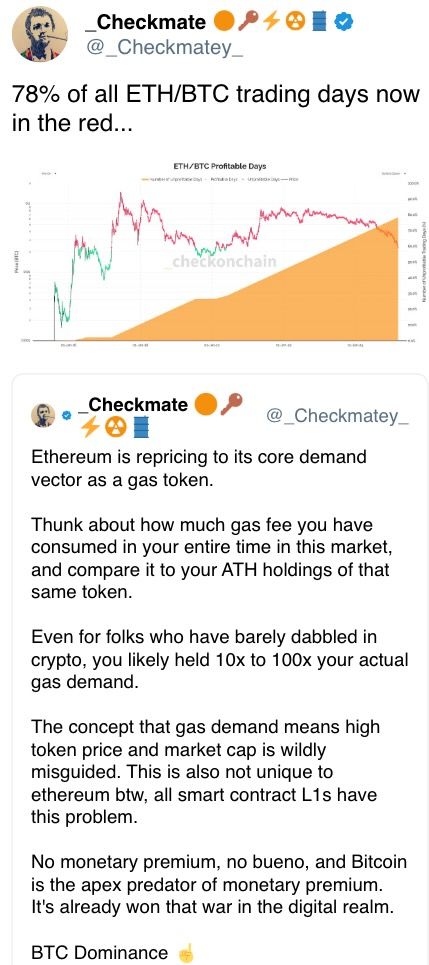
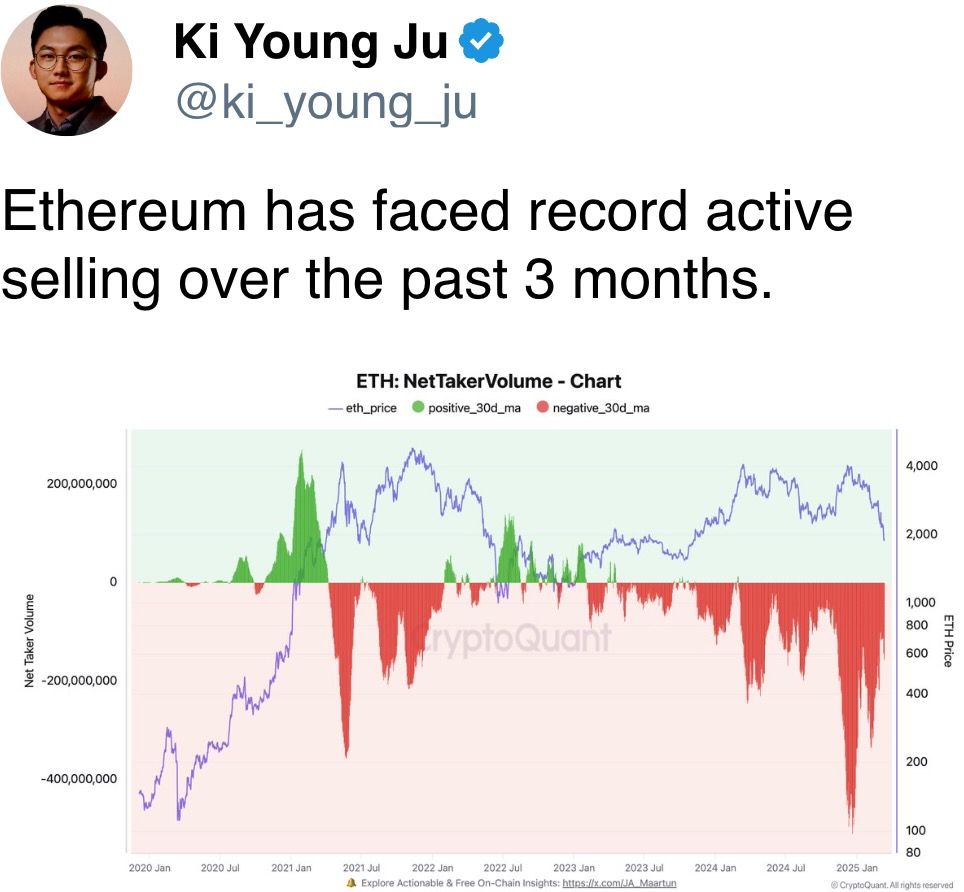
Uncategorized
Solana Steals the Spotlight as Fed Rate Cut Nears: Crypto Daybook Americas

By Omkar Godbole (All times ET unless indicated otherwise)
Suddenly, it’s all about Ethereum rival Solana and its native token SOL as the broader market holds its breath ahead of Wednesday’s Federal Reserve rate decision.
Michael Novogratz, the founder and CEO of Galaxy Investment, says Solana could evolve to become a settlement infrastructure in global finance. Why? Because the blockchain can handle over 6 billion transactions a day, which is way higher than the 400 million-700 million trades global securities markets usually deal with, he said. Speed matters.
At BaseCamp 2025, Coinbase’s layer-2 network hinted at plans for a token launch that could accelerate decentralization and unveiled a Solana bridge to boost cross-chain connectivity. Pantera Capital’s Dan Morehead announced that Solana is their largest bet, valued at $1.1 billion, calling it the fastest and best-performing blockchain, which has outpaced even Bitcoin over the past four years.
If that’s not enough, Kyle Samani, chairman of Nasdaq-listed Solana treasury company Forward Industries, said over the weekend that the company plans to deploy funds to boost the Solana-native decentralized finance ecosystem.
All these signs suggest SOL could outperform bitcoin (BTC), ether (ETH) and other major tokens if the Fed cuts rates by the 25 basis points this week, as expected. If it surprises with a 50-basis-point move, things could get wild. Keep your eyes on those SOL/BTC and SOL/ETH trading pairs.
Currently, SOL is trading around $235 after peaking near $250 over the weekend. Other major cryptocurrencies are stuck in neutral, trailing behind stocks, which continue to hit fresh highs.
On the stablecoin front, the Bank of England proposed limits on how the value of dollar-backed stablecoins an individual can hold, as low as 10,000 pounds ($13,600), citing systemic risks. Stani Kulechov, Aave’s CEO, called the move “absurd” and urged the crypto community to stand up against such regulations.
More countries, especially those with current account deficits, will likely consider similar measures to curb outflows that dodge traditional banks.
And as for the traditional markets, Monday’s mix of rising stocks and the VIX, Wall Street’s fear gauge, has some observers raising their eyebrows. History shows these moments often precede market corrections, so stay alert!
What to Watch
- Crypto
- Sept. 16, 12 p.m.: Solana Live event on X. Guests include Pump.fun co-founder Alon Cohen and Kyle Samani, chairman of Forward Industries (FORD) and the managing partner of Multicoin Capital.
- Macro
- Sept. 16, 8 a.m.: Brazil July unemployment rate Est. 5.7%.
- Sept. 16, 8:30 a.m.: Canada August headline CPI YoY Est. 2%, MoM Est. 0%; core YoY Est. N/A (Prev. 2.6%), MoM Est. N/A (Prev. 0.1%).
- Sept. 16, 8:30 a.m.: U.S. August retail sales YoY Est. N/A (Prev. 3.9%), MoM Est. 0.3%.
- Earnings (Estimates based on FactSet data)
- None scheduled.
Token Events
- Governance votes & calls
- Curve DAO is voting to update donation-enabled Twocrypto contracts, refining donation vesting so unlocked portions persist after burns. Voting ends Sept. 16.
- Sept. 16: Aster Network to host a community call.
- Sept. 18, 6 a.m.: Mantle to host Mantle State of Mind, a monthly downhill series.
- Sept. 16, 12 p.m.: Kava to host a community Ask Me Anything (AMA) session.
- Unlocks
- Sept. 16: Arbitrum (ARB) to unlock 2.03% of its circulating supply worth $45.92 million.
- Token Launches
- Sept. 16: Merlin (MRLN) to be listed on Binance Alpha, MEXC, BitMart, Gate.io, and others.
Conferences
- Day 2 of 7: Budapest Blockchain Week 2025 (Budapest, Hungary)
- Day 1 of 2: Real-World Asset Summit (New York)
Token Talk
By Oliver Knight
- As the crypto market stays within a tight range after a brief peak and trough on Monday, one token is running its own race: IMX is up 15% in the past 24 hours with daily trading volume doubling to $144 million.
- The rise lifted IMX, the native token of Web3 gaming platform Immutable, to a five-month high.
- Bullish sentiment around Immutable can be attributed to an SEC probe that was dropped earlier this year and general optimism around the gaming sector. Gaming is estimated to reach $200 billion in revenue this year with further growth forecast in 2026 alongside the release of Rockstar Gaming’s Grand Theft Auto 6.
- Immutable is well positioned to capitalize on that growth after teaming up with gaming giant Ubisoft on the next iteration of Might and Magic Fates in April.
- Blockchain technology could have a key role to play in gaming if trends shift toward in-game ownership of items, which could see the implementation of non-fungible tokens (NFTs) within a game that could then be collected or sold on for crypto tokens.
- IMX is currently trading at $0.736 having broken out of a key level of resistance. It will likely come back to test $0.70 as support before potentially moving higher, provided trading volume can sustain at these levels.
Derivatives Positioning
- Most major cryptocurrencies, including BTC and ETH, continued to experience capital outflows from futures, leading to a decline in open interest.
- AVAX stands out with OI rising over 14% as the token’s market cap looks to climb above $13 billion for the first time since Feb. 2.
- Solana OI has reached a record high of over 70 million SOL, with positive funding rates pointing to bullish capital inflows.
- On the CME, OI in solana futures pulled back to 7.63 million SOL from the record 8.12 million SOL on Sept. 12. Still, the three-month annualized premium holds well above 15%, offering an attractive yield for carry traders.
- BTC CME OI continues to improve, but overall positioning remains light relative to ether and SOL futures.
- On Deribit, the bias for BTC and ETH put options continues to ease across all tenors as traders anticipate Fed rate cuts. SOL and XRP options remain biased bullish.
- On OTC network Paradigm, block flows featured BTC calendar spreads and shorting of call and put options.
Market Movements
- BTC is unchanged from 4 p.m. ET Monday at $115,500.55 (24hrs: +0.54%)
- ETH is unchanged at $4,513.45 (24hrs: -0.49%)
- CoinDesk 20 is up 0.48% at 4,271.28 (24hrs: +0.71%)
- Ether CESR Composite Staking Rate is up 5 bps at 2.87%
- BTC funding rate is at 0.0059% (6.4616% annualized) on Binance

- DXY is down 0.32% at 96.99
- Gold futures are up 0.42% at $3,734.70
- Silver futures are up 0.53% at $43.19
- Nikkei 225 closed up 0.3% at 44,902.27
- Hang Seng closed unchanged at 26,438.51
- FTSE is down 0.22% at 9,256.41
- Euro Stoxx 50 is unchanged at 5,437.55
- DJIA closed on Monday up 0.11% at 45,883.45
- S&P 500 closed up 0.47% at 6,615.28
- Nasdaq Composite closed up 0.94% at 22,348.75
- S&P/TSX Composite closed up 0.5% at 29,431.02
- S&P 40 Latin America closed up 1.64% at 2,904.55
- U.S. 10-Year Treasury rate is unchanged at 4.037%
- E-mini S&P 500 futures are up 0.19% at 6,633.75
- E-mini Nasdaq-100 futures are up 0.29% at 24,380.00
- E-mini Dow Jones Industrial Average Index are unchanged at 45,902.00
Bitcoin Stats
- BTC Dominance: 58.11% (unchanged)
- Ether to bitcoin ratio: 0.03907 (-0.36%)
- Hashrate (seven-day moving average): 1,025 EH/s
- Hashprice (spot): $53.98
- Total Fees: 4.41 BTC / $508,109
- CME Futures Open Interest: 140,975 BTC
- BTC priced in gold: 31.2 oz
- BTC vs gold market cap: 8.82%
Technical Analysis
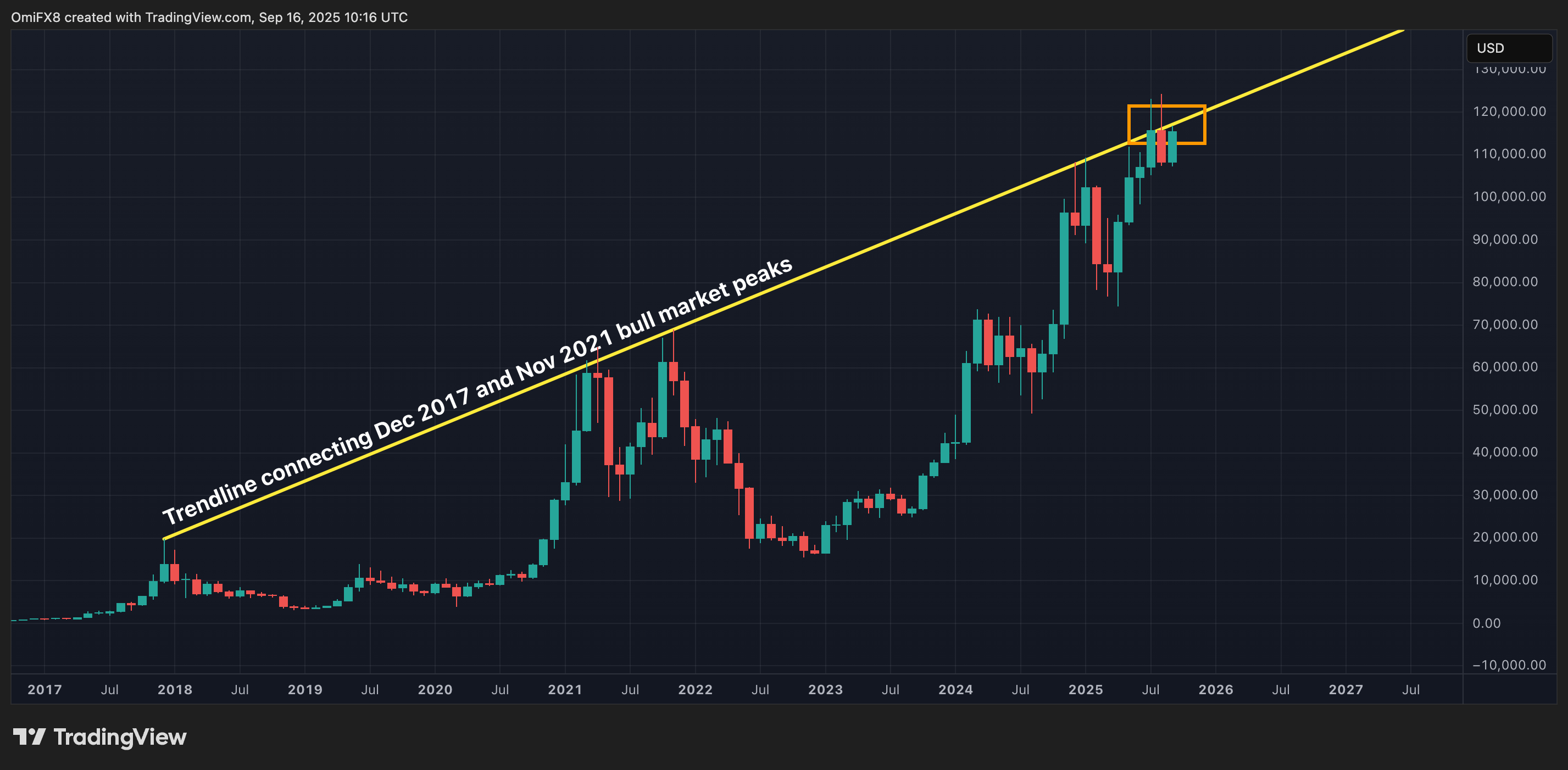
- The monthly chart shows that BTC is again probing the trendline connecting the previous bull market peaks.
- Bulls failed to establish a foothold above that trendline in July and August.
- A third straight failure could really embolden sellers, potentially yielding a deeper drop.
Crypto Equities
- Coinbase Global (COIN): closed on Monday at $327.02 (+1.23%), +0.27% at $327.91
- Circle (CRCL): closed at $134.05 (+6.97%), unchanged in pre-market
- Galaxy Digital (GLXY): closed at $30.77 (+3.6%), +0.58% at $30.95
- Bullish (BLSH): closed at $51.08 (-1.47%), +0.59% at $51.38
- MARA Holdings (MARA): closed at $16.24 (-0.43%), unchanged in pre-market
- Riot Platforms (RIOT): closed at $16.68 (+4.97%), +1.08% at $16.86
- Core Scientific (CORZ): closed at $16.32 (+2.9%), +0.37% at $16.38
- CleanSpark (CLSK): closed at $10.29 (-0.58%), +0.1% at $10.30
- CoinShares Valkyrie Bitcoin Miners ETF (WGMI): closed at $38.73 (+3.78%), +1.96% at $39.49
- Exodus Movement (EXOD): closed at $27.88 (-1.69%), -1.94% at $27.34
Crypto Treasury Companies
- Strategy (MSTR): closed at $327.79 (-1.1%), +0.34% at $328.89
- Semler Scientific (SMLR): closed at $28.39 (-2.74%)
- SharpLink Gaming (SBET): closed at $16.79 (-5.14%), +0.54% at $16.88
- Upexi (UPXI): closed at $6.33 (-6.29%), +0.95% at $6.39
- Lite Strategy (LITS): closed at $3.07 (+10.43%)
ETF Flows
Spot BTC ETFs
- Daily net flows: $259.9 million
- Cumulative net flows: $57.05 billion
- Total BTC holdings ~1.31 million
Spot ETH ETFs
- Daily net flows: $359.7 million
- Cumulative net flows: $13.74 billion
- Total ETH holdings ~6.53 million
Source: Farside Investors
While You Were Sleeping
- Gold Uptrend Intact, but Due for Correction Before Topping $4,000 in 2026 (Reuters): Gold has surged 40% in 2025, outpacing the S&P 500. Analysts warn it looks overbought and may decline before targeting $4,000 next year.
- Coinbase Policy Chief Pushes Back on Bank Warnings That Stablecoins Threaten Deposits (CoinDesk): Coinbase’s Faryar Shirzad said concerns of stablecoin deposit flight are myths, claiming banks are really defending profits from an outdated payments system.
- King Charles Rolls Out the Red Carpet to Woo Trump (The Wall Street Journal): U.K. Prime Minister Keir Starmer is using royal pageantry to sway Trump on tariffs and European security, while the visit will showcase new U.S.-U.K. cooperation in technology and energy.
- Deutsche Börse’s Crypto Finance Unveils Connected Custody Settlement for Digital Assets (CoinDesk): The Deutsche Börse subsidiary launched AnchorNote in Switzerland, letting institutions trade digital assets across venues while keeping them in custody to cut counterparty risk and improve capital efficiency.
Uncategorized
ORQO Debuts in Abu Dhabi With $370M in AUM, Sets Sight on Ripple USD Yield

ORQO Group, a new institutional asset manager with $370 million in assets under management, has launched on Tuesday with plans to build out a yield platform for Ripple’s RLUSD stablecoin.
The group, headquartered in Abu Dhabi, consolidates four entities from both traditional finance and digital assets: Mount TFI, a private debt specialist and licensed fund manager in Poland, Monterra Capital, a multi-strategy digital hedge fund in Malta, blockchain engineering studio Nextrope and decentralized finance (DeFi) protocol Soil compliant with MiCA, the EU’s crypto framework.
Already licensed in Poland and Malta, the group is seeking approval from the Financial Services Regulatory Authority at Abu Dhabi Global Market to expand services in the Middle East, a region it sees as a hub for regulated digital asset growth.
«It’s an opportunity to become a global on-chain asset manager,» ORQO CEO Nicholas Motz said in an interview with CoinDesk. «We have all the pieces: the off-chain asset management, and on-chain, too.»
ORQO’s effort is part of a larger trend that’s been reshaping crypto markets: moving traditional financial instruments like private credit, U.S. Treasuries, or trade finance deals onto blockchain networks. The process is also known as tokenization of real-world assets (RWAs). Data from rwa.xyz shows that the RWA market has grown into a nearly $30 billion sector, though it remains tiny compared to traditional finance markets such as the $2 trillion private credit sector. Still, the growth potential is immense: the tokenized RWA market could reach $18.9 trillion by 2033, a joint report by Ripple and BCG projected.
Yield platform Soil is a key piece in ORQO’s gameplan, connecting the firm’s RWA access with crypto capital capital. It aims to provide returns on stablecoins deposits from tokenized private credit, real estate and hedge fund strategies.
As part of the next stage, the firm plans to open several credit pools targeting holders of Ripple’s RLUSD stablecoin in the near future, allowing investors such as institutional treasuries or protocol reserves to earn a yield on their holdings.
Read more: Tokenization of Real-World Assets is Gaining Momentum, Says Bank of America
Uncategorized
Coinbase Policy Chief Pushes Back on Bank Warnings That Stablecoins Threaten Deposits

Contrary to claims from the U.S. banking industry, stablecoins do not pose a risk to the financial system, according to the chief policy officer at crypto exchange Coinbase (COIN), Faryar Shirzad. Banks’ claims that they do are are myths crafted to defend their revenues, he wrote in a Tueday blog post.
«The central claim — that stablecoins will cause a mass outflow of bank deposits — simply doesn’t hold up,» Shirzad wrote. «Recent analysis shows no meaningful link between stablecoin adoption and deposit flight for community banks and there’s no reason to believe big banks would fare any worse.»
Larger lenders still hold trillions of dollars at the Federal Reserve and if deposits were really at risk, he argued, they would be competing harder for customer funds by offering higher interest rates rather than parking cash at the central bank
According to Shirzad, the real reason for banks’ opposition is the payments business. Stablecoins, digital tokens whose value is pegged to a real-life asset such as the dollar, offer faster and cheaper ways to move money, threatening an estimated $187 billion in annual swipe-fee revenue for traditional card networks and banks.
He compared the current pushback to earlier battles against ATMs and online banking, when incumbents warned of systemic dangers but, he said, were ultimately trying to protect entrenched profits.
Shirzad also dismissed reports predicting trillions in potential outflows from deposits into stablecoins, whose total market cap is around $290 billion, according to data from CoinGecko. He stressed that stablecoins are primarily used as payment tools — for trading digital assets or sending funds abroad — not as long-term savings products.
Someone purchasing stablecoins to settle with an overseas supplier, he argued, is opting for a more efficient transaction method the going through their bank, not pulling money from a savings account.
He urged banks to embrace the technology instead of resisting it, saying stablecoin rails could cut settlement times, lower correspondent banking costs and provide round-the-clock payments. Those institutions willing to adapt, he wrote, stand to benefit from the shift.
The U.K., too, faces concerns about the effect of stablecoins on the financial industry.
The Financial Times reported Monday that the Bank of England is considering setting limits on how many «systemic» stablecoins people and companies can hold — setting thresholds as low as 10,000 pounds ($13,600) for individuals and about 10 million pounds for businesses.
Officials define systemic stablecoins as those already widely used for U.K. payments or expected to become so, and say the caps are needed to prevent sudden deposit outflows that could weaken lending and financial stability.
-

 Business11 месяцев ago
Business11 месяцев ago3 Ways to make your business presentation more relatable
-

 Fashion11 месяцев ago
Fashion11 месяцев agoAccording to Dior Couture, this taboo fashion accessory is back
-

 Entertainment11 месяцев ago
Entertainment11 месяцев ago10 Artists who retired from music and made a comeback
-

 Entertainment11 месяцев ago
Entertainment11 месяцев ago\’Better Call Saul\’ has been renewed for a fourth season
-

 Entertainment11 месяцев ago
Entertainment11 месяцев agoNew Season 8 Walking Dead trailer flashes forward in time
-

 Business11 месяцев ago
Business11 месяцев ago15 Habits that could be hurting your business relationships
-

 Entertainment11 месяцев ago
Entertainment11 месяцев agoMeet Superman\’s grandfather in new trailer for Krypton
-

 Entertainment11 месяцев ago
Entertainment11 месяцев agoDisney\’s live-action Aladdin finally finds its stars





